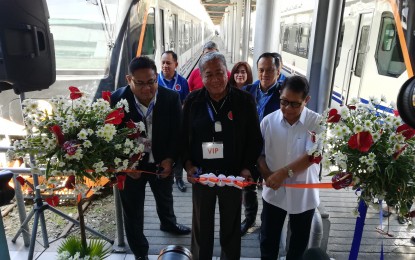
NEW TRAINS. Department of Transportation Secretary Arthur Tugade (center) Philippine National Railways (PNR) general manager Junn Magno (left), and other officials cut the inaugural ribbon during the send-off ceremony of the PNR's two new diesel multiple unit trains. Magno said the two new trains will ply the Tutuban-Alabang route, adding about 20,000 daily passenger capacity and shortening the route's headway to only 20 minutes. (PNA photos by Raymond Carl Dela Cruz)
MANILA – Two new trains have officially joined the Philippine National Railways’ (PNR) Tutuban - Alabang route after its class assignment and send-off ceremony on Thursday.
In an interview at the Tutuban Station, PNR general manager Junn Magno said the two new 8100 series diesel multiple unit (DMU) train sets, which consisted of four cars each, can each carry up to 1,000 passengers at a time.
He said with the two new trains, the route will now have a total of five trains, resulting in a headway, or the time gap between trains, of only 20 minutes.
Manufactured by PT INKA, a rolling stock manufacturer fully-owned by the Indonesian government, Magno said the trains are also equipped with added features such as more handholds for increased passenger capacity and safety.
“Sa may middle area may handholds kami, para yung capacity ng handholds halos maging doble (In the middle-area we installed handholds so that the capacity of handholds is doubled),” Magno said.

Another feature is the air-conditioning units installed in the new trains—built to withstand tropical climates unlike the air-conditioning units installed in the PNR’s old trains, Magno said.
“Hindi po yung galing Hapon katulad ng mga lumang tren namin na pang-temperate regions. Ito pang-tropical na area na. Hanggang 46,000 kilocalories ang kaya niya (This is not like those Japanese units of our old trains that were originally made for temperate regions. This one is for tropical areas. It is capable of a 46,000 kilocalories output),” Magno said.
Other features of the trains are its poly-carbonate windows capable of withstanding moderate damage caused by thrown rocks, automatic safety doors, and a modular system design that would allow the PNR to repair or replace damaged components in a relatively short time.

Following the ceremony, Magno and Department of Transportation (DOTr) Secretary Arthur Tugade boarded one of the new trains and rode from Tutuban to Dela Rosa Station in Makati City before its first commercial operation.

Afterward, the train went to the FTI Station in Taguig and began loading passengers going to Tutuban Station.
In an interview, Tugade said the four newest trains of the PNR will soon be joined by another five new trains by June this year.
He said the nine new trains will add a total of 92,000 daily passenger capacity to the rail service, inching closer to the 200,000 daily passenger capacity target of the PNR in the region. (PNA)
